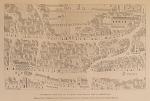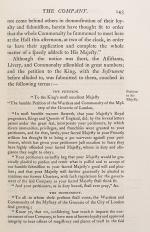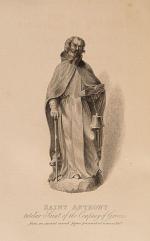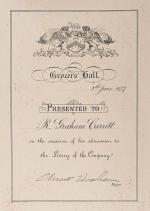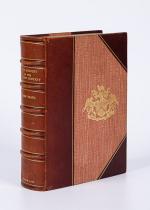Heath, Some Account of the Worshipful Company of Grocers of the City of London.
Some Account of the Worshipful Company of Grocers of the City of London.
Third Edition. London, Privately Printed, 1869. Large Octavo. Frontispiece (Saint Anthony, tutelar Saint of the Company of Grocers), XVI, 601 pages with many illustrations (steel-engravings) and one facsimile. Hardcover / Original publishers quarter morocco with gilt lettering on spine and Emblemata on cover. Top edge gilt. Only some faint signs of dampstain to the outer margins of the illustrations. Otherwise in splendid condition with only minor signs of external wear. Presentation copy from Master Ernest Woodhame to R. Graham Carritt on the occasion of his admission to the Livery of the Company in June 1927. With a bookplate of Grocer’s Hall to the front pastedown.
The Worshipful Company of Grocers is one of the 110 Livery Companies of the City of London and ranks second in order of precedence. Established in 1345, the Grocers comprise one of London’s Great Twelve City Livery Companies. The company was founded in the 14th century by members of the Guild of Pepperers, which dates from 1180. The Company was responsible for maintaining standards for the purity of spices and for the setting of certain weights and measures. Its members included London’s pharmacists, who separated forming the Worshipful Society of Apothecaries in 1617.
The guild was known as the Company of Grossers from 1373 until 1376 when it was renamed the Company of Grocers of London. In 1428, two years after building its first hall in Old Jewry, the Company was granted a Royal Charter by King Henry VI of England. One of the Great Twelve City Livery Companies, it ranks second in the Companies order of precedence after the Mercers’ Company. It is said that the Grocers’ Company used to be first in the order, until Queen Elizabeth I, as Honorary Master of the Mercers’ Company, found herself in procession, after her coronation behind the Grocers’ camel which was emitting unfortunate smells; as a result, the Mercers were promoted. Today, the Grocers’ Company exists as a charitable, constitutional and ceremonial institution which plays a significant role in the election of and supporting the Lord Mayor and the Sheriffs of the City of London. The Company’s motto is “God Grant Grace”. The Company also provides banqueting and conference facilities at Grocers’ Hall situated in Prince’s Street, next to the Bank of England. The earliest known Grocers’ Hall was in Poultry, London, then known as Conningshop-lane on account of the three conies or rabbits hanging over a poulterer’s stall in the lane. It was built in 1428 on land once owned by Lord Fitzwalter and let out “for dinners, funerals, county feasts and weddings.” The roof and woodwork of the hall were destroyed in the 1666 Great Fire and afterwards a new roof was erected on the old walls while Sir John Cutler, 1st Baronet paid for a new parlour and dining room. The hall was again renovated in 1681 by the future Lord Mayor of London, Sir John Moore. A new hall was built on the same site between 1798 and 1802 when part of the garden was sold to the Bank of England for the expansion of nearby Prince’s Street. However, frequent and extensive repairs were required due to defective foundations in the building, which was replaced by a fourth hall, completed in 1893 on Prince’s Street. The hall survived the Blitz with only minor damage to its north wing, but was almost completely destroyed by a fire in 1965, apparently caused by a lightbulb left on in the grand staircase beneath an oak lintel which smouldered and eventually caught fire. A fifth and final hall was constructed nearby in 1970, also on Prince’s Street, which remains the Grocers’ home today. The present Master Grocer for 2018-19 is James Whitmore and the Company’s Clerk is Brigadier Greville Bibby. The Company is responsible for the maintenance of Oundle School at Oundle, Northamptonshire, which uses the Grocers’ crest of a camel as its school badge, and of the Elms School in Colwall, Herefordshire. Reed’s School’s Annual Foundation Appeal has been held at Grocers’ Hall for over fifty years. Additionally, in 1876 the Company founded the Grocers’ Company School, in Hackney, east of the City of London, for the education of “sons of the middle classes”. This was transferred into London County Council’s control after that authority’s formation in 1889 and changed its name to Hackney Downs School; it closed in 1995. The school depicted as its school badge a camel, for the Lower School, and a shield with cloves and the motto of the Grocers’ Company for the Upper School; the Camel and Cloves are remembered to this day by old boys of the school through the Clove Club for former pupils. The Grocers’ Company now maintains close links with and is the principal sponsor of Hackney’s Mossbourne Academy, renowned for its excellent educational standards. The Company is also affiliated to HMS Queen Elizabeth, the first of the Royal Navy’s new Queen Elizabeth-class aircraft carriers, and with the Coldstream Guards, the British Army’s oldest regular regiment.
Eglinton Village in County Londonderry, Northern Ireland, was established by the Grocers’ Guild in 1619, under the name of Muff; the local Castle Credit Union adopted the use of the Company’s crest, as has Eglinton Primary School. The church of St Mary the Virgin at Northill in Bedfordshire shows the Grocers’ coat of arms on a stained glass window by John Oliver. The company commissioned the window in 1664. (Wikipedia)
- Keywords: Economic history · Economics – Rare · English History – Rare · English History Collection · English Industrial History · English Literature – Rare · London – Rare · London – Section of English History Collection
- Language: English
- Inventory Number: 101523AB
EUR 480,--
© 2025 Inanna Rare Books Ltd. | Powered by HESCOM-Software





